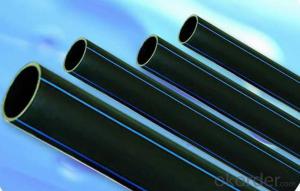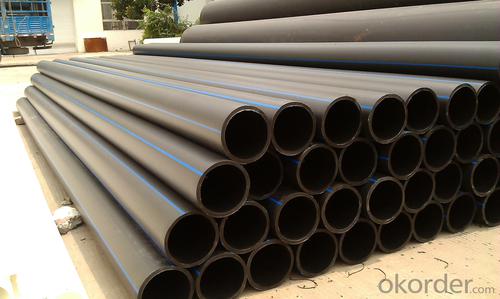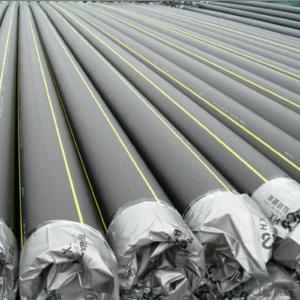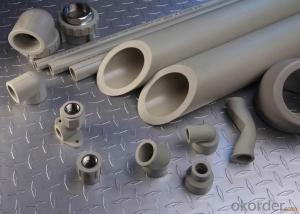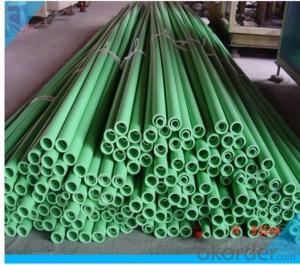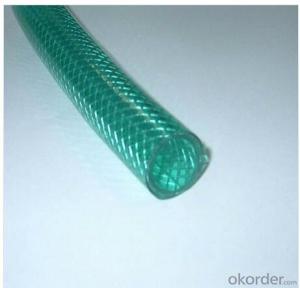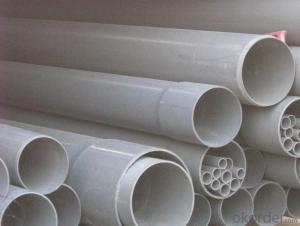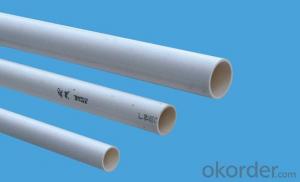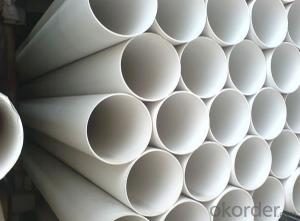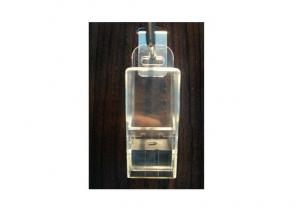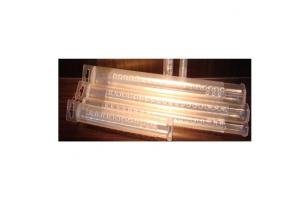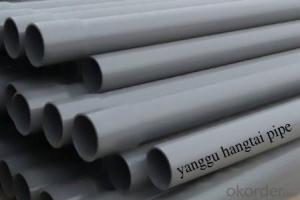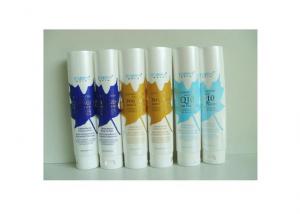Plastic Tubes HDPE Pipe ISO4427-2000 DN180
- Loading Port:
- China Main Port
- Payment Terms:
- TT OR LC
- Min Order Qty:
- -
- Supply Capability:
- -
OKorder Service Pledge
OKorder Financial Service
You Might Also Like
Physical properties[edit]
Polyethylene is a thermoplasticpolymer consisting of long hydrocarbon chains. Depending on the crystallinity and molecular weight, a melting point and glass transition may or may not be observable. The temperature at which these occur varies strongly with the type of polyethylene. For common commercial grades of medium- and high-density polyethylene the melting point is typically in the range 120 to 180 °C (248 to 356 °F). The melting point for average, commercial, low-density polyethylene is typically 105 to 115 °C (221 to 239 °F).it is transprant.
Chemical properties[edit]
Most LDPE, MDPE and HDPE grades have excellent chemical resistance, meaning that it is not attacked by strong acids or strong bases. It is also resistant to gentle oxidants and reducing agents. Polyethylene burns slowly with a blue flame having a yellow tip and gives off an odour of paraffin. The material continues burning on removal of the flame source and produces a drip.[3] Crystalline samples do not dissolve at room temperature. Polyethylene (other than cross-linked polyethylene) usually can be dissolved at elevated temperatures in aromatic hydrocarbons such as toluene or xylene, or in chlorinated solvents such as trichloroethane or trichlorobenzene.[4]
GB/T13663-2000:
| PE63管材规格 | |||||
| 公称 外径dn,mm | SDR33 | SDR26 | SDR17.6 | SDR13.6 | SDR11 |
| 公称压力 PN,Mpa | |||||
| 0.32 | 0.4 | 0.6 | 0.8 | 1.0 | |
| 公称 壁厚 | 公称 壁厚 | 公称 壁厚 | 公称 壁厚 | 公称 壁厚 | |
| 16 | 2.3 | ||||
| 20 | 2.3 | 2.3 | |||
| 25 | 2.3 | 2.3 | 2.3 | ||
| 32 | 2.3 | 2.4 | 2.9 | ||
| 40 | 2.3 | 2.3 | 3.0 | 3.7 | |
| 50 | 2.3 | 2.9 | 3.7 | 4.6 | |
| 63 | 2.3 | 2.5 | 3.6 | 4.7 | 5.8 |
| 75 | 2.3 | 2.9 | 4.3 | 5.6 | 6.8 |
| 90 | 2.8 | 3.5 | 5.1 | 6.7 | 8.2 |
| 110 | 3.4 | 4.2 | 6.3 | 8.1 | 10.0 |
| 125 | 3.9 | 4.8 | 7.1 | 9.2 | 11.4 |
| 140 | 4.3 | 5.4 | 8.0 | 10.3 | 12.7 |
| 160 | 4.9 | 6.2 | 9.1 | 11.8 | 14.6 |
| 180 | 5.5 | 6.9 | 10.2 | 13.3 | 16.4 |
| 200 | 6.2 | 7.7 | 11.4 | 14.7 | 18.2 |
| 225 | 6.9 | 8.6 | 12.8 | 16.6 | 20.5 |
| 250 | 7.7 | 9.6 | 14.2 | 18.4 | 22.7 |
| 280 | 8.6 | 10.7 | 15.9 | 20.6 | 25.4 |
| 315 | 9.7 | 12.1 | 17.9 | 23.2 | 28.6 |
| 355 | 10.9 | 13.6 | 20.1 | 26.1 | 32.2 |
| 400 | 12.3 | 15.3 | 22.7 | 29.4 | 36.3 |
| 450 | 13.8 | 17.2 | 25.5 | 33.1 | 40.9 |
| 500 | 15.3 | 19.1 | 28.3 | 36.8 | 45.4 |
| 560 | 17.2 | 21.4 | 31.7 | 41.2 | 50.8 |
| 630 | 19.3 | 24.1 | 35.7 | 46.3 | 57.2 |
- Q: Are plastic tubes suitable for medical diagnostics?
- Yes, plastic tubes are suitable for medical diagnostics. They are commonly used in various diagnostic procedures, such as blood collection, urine testing, and sample storage. Plastic tubes are lightweight, cost-effective, and have excellent chemical resistance, making them suitable for handling and transporting biological samples in a safe and efficient manner. Additionally, they are available in different sizes and configurations to accommodate specific diagnostic needs.
- Q: Plastic tubing is touching compressor (or close to it) and gets hot and brittle. I recoupled a bad spot 1 year ago and it is leaking again. I would like to replace the tubing from the back of the refrig (solenoid) to the water filter. Any ideas on what material to use? I would like to use copper line thru the bottom of the refrig if not all the way to the water filter, but don't know how to connect it to the solenoid. Also would pex (1/4 OD) line be a better (albeit more expensive) choice for this?
- You can replace the line with copper. If the connection point is metal you'll want to use a brass compression nut (brass) with a (brass) compression sleeve (know as a ferrules) if the connection point is plastic you'll want to use a nylon compression fitting. The metal ferrules one wont work as you would need to crank the you know what out out it to make it seal, and run the risk of stripping the plastic threads. The nylon takes less torque to seal if that makes sense as its a more dense material. You should be able to get all the parts from a local hardware store or big box store such as lowes or homedepot.
- Q: Are plastic tubes easy to install?
- Yes, plastic tubes are relatively easy to install as they are lightweight, flexible, and can be easily cut and connected using various fittings or connectors. Additionally, they do not require any specialized tools or expertise for installation.
- Q: Can plastic tubes be used for chemical transfer?
- Yes, plastic tubes can be used for chemical transfer. They are commonly used in various industries for transferring a wide range of chemicals due to their resistance to corrosion, affordability, and flexibility. However, the choice of plastic material should be carefully considered based on the specific chemical being transferred, as some chemicals may react with certain types of plastics.
- Q: Are plastic tubes resistant to impact from freezing temperatures?
- Plastic tubes can vary in their resistance to impact from freezing temperatures. Some plastic materials, like PVC or HDPE, are generally more resistant to impact and cracking caused by freezing temperatures. However, it is important to consider the specific type of plastic used and any additives or reinforcements that may affect its performance. Additionally, extreme cold temperatures could still potentially cause damage to plastic tubes, especially if subjected to significant impact or pressure.
- Q: Does anyone know of a way to attach a hollow plastic tube that is 2 inches long with a diameter about 0.5 in to a rectangular piece of wood that is 0.75 in thick? It has to be able to withstand considerable force without budging. Something like duck tape doesn't work, I've tried.Is there a good way to do this? I was thinking of some sort of clamp, but what type? And is there any sort of glue I could get that is very strong?I'd appreciate any help.
- Drill a hole in the wood and glue the tube into it. Does it have to be wood? It might be better to use a block of plastic and drill a hole instead of trying to attach a tube.
- Q: They were little plastic tubes filled water and sometimes little animals. You would try to hold it, the it would go inside-out and fall. They were really popular in the 90's.
- So many different versions of them, but I knew them as Liquid Tumblers. Got 'em from Chuck E. Cheese :3
- Q: Reinforced concrete walls are eyes, and some have plastic tubes on their eyes, what's the matter?
- A fixed formwork used for pouring concrete through formwork clips
- Q: This Saturday I'm going tubing in the Guadalupe River and I'm FREAKING out. I know how to swim but I'm just scared of waterfalls and really rough and tough water. Any information about the rivers currents and the flow will be nice. Also any advise would be greatly appreciated. (The cfs is currently 68 if that is important)
- EXCELLENT tubing on the Guadalupe River in New Braunfels. Rented hard plastic bottom tubes (once you get to the mini rapids, you'll be glad you got the hard bottom to save your butt from pain) to go down this awesome natural lazy river. Rented the tubes from Rockin R Rivers tubes off of Gruene in New Braunfels. So fun. They pick you up at one of two different spots down the river in a caravan, so you don't have to worry about getting back. You can bring a cooler with non trash items, food, and toys. We had a cooler float, drinks, food, and our beach jai alai game It was just across the river from the bed n breakfast we stayed at. The Gruene Hotel. And right next to the fantastic restaurant Gristmill River Restaurant Bar
- Q: What are X-ray specs and Wonder tubes?
- X-Ray Specs are an American novelty item, purported to allow the user to see through or into solid objects. In reality the glasses merely create an optical illusion; no X-rays are involved. The current version is sold under the name X-Ray Spex; an essentially identical product is sold under the name X-Ray Gogs. X-Ray Specs consist of an outsized pair of glasses with plastic frames and white cardboard lenses printed with concentric red circles, and emblazoned with the legend X-RAY VISION. The lenses consist of two layers of cardboard with a small hole about 6 mm (.25 inch) in diameter punched through both layers. The user views objects through the holes. A feather is embedded between the layers of each lens. The vanes of the feathers are so close together that light is diffracted, causing the user to receive two slightly offset images. For instance, one would see two offset images of the pencil. Where the images overlap, a darker image is obtained, supposedly giving the illusion that one is seeing the graphite embedded within the body of the pencil. As may be imagined, the illusion is not particularly sustainable. What's a Wonder Tube? you wonder? It's a plastic tube with a screw-on cap... but that isn't important. A Wonder Tube? is full of wonder! It's the most wonderous Wonder Tube? known to mankind! The more you look at it, the more creative, wonderful uses you will find for it. We even include an Idea Sheet with a gazillion (okay, maybe a few dozen) ideas to help get you wondering... Product Size: 1 diameter x 5-3/4 long These giant plastic test tubes are virtually indestructible test tubes! Grow plants, observe critters, capture a crystal-like rainbow, or make a wave bottle. Use your imagination, and you will discover dozens of uses for these giant test tubes! These plastic test tubes can be used again and again and will last for years. Children find the most interesting ways to play with these bottles - they are a great open-ended toy for experimentation.
Send your message to us
Plastic Tubes HDPE Pipe ISO4427-2000 DN180
- Loading Port:
- China Main Port
- Payment Terms:
- TT OR LC
- Min Order Qty:
- -
- Supply Capability:
- -
OKorder Service Pledge
OKorder Financial Service
Similar products
Hot products
Hot Searches
Related keywords

